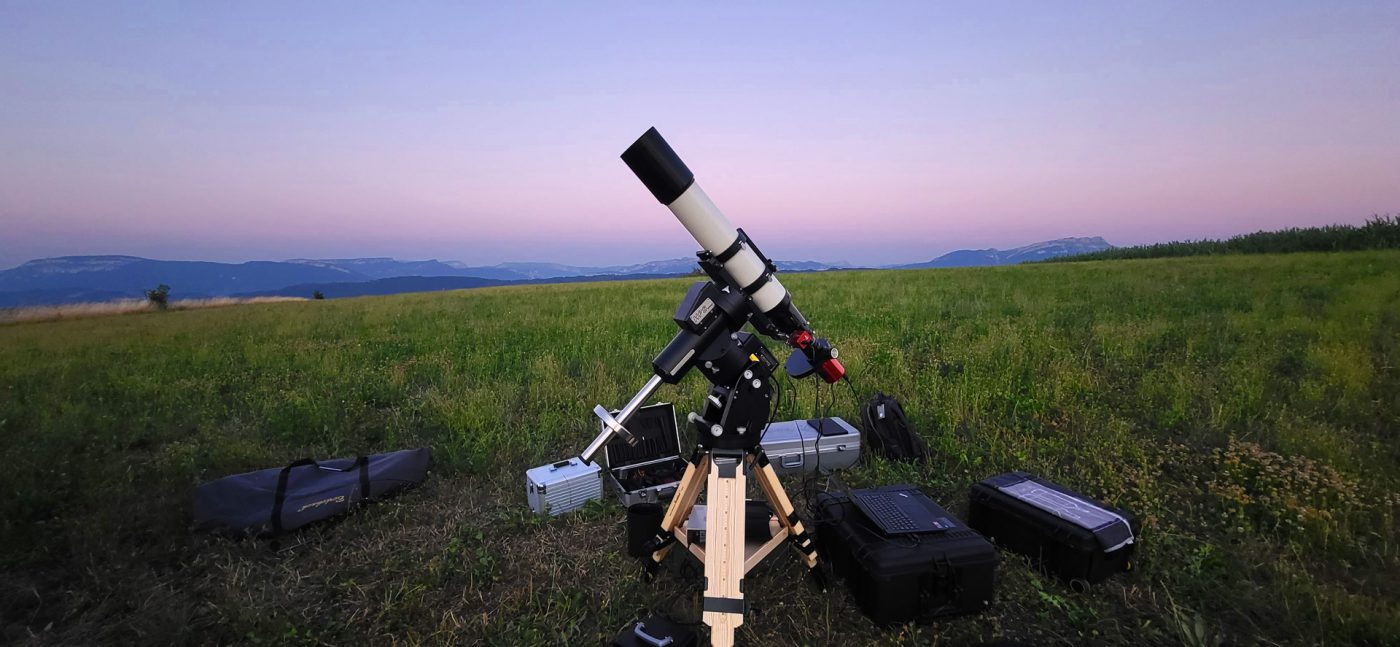NP127is: Image of the Day!
Nicola Beltraminelli’s astro-imaging work first came to our attention when he won the AstroBin Image of the Day on 01 October 2022 for his Lion Nebula image taken with the Tele Vue NP127is APO refractor. Reviewers praise the effort for bringing out the complexity of the nebula with striking details and colors. Looking through his AstroBin wall we found many more excellent Tele Vue-NP127is images including an AstroBin Silver Badge Top Pick, all shot from locations in southeast France. He has written extensive descriptions for each image that includes his thoughts on imaging each one. So, we present in his own words an image gallery of his work. Click the image title to see the original on AstroBin along with more technical details.
The Clamshell Nebula (Sh2-119) — AstroBin Silver Badge Top Pick
The Clamshell Nebula (2,200 light-years away) is frequently overlooked for two reasons: it’s only 2-3 degrees away from the more famous North American and Pelican Nebulae and is quite faint with weak emission in Hα, very weak in SII, and extremely weak in OIII. The bright star (the pearl in this picture) is 68 Cygni. About magnitude 5, it is one of the stars responsible for ionizing the nebula gas to glow. Riddled throughout this complex are several brighter emission patches and dark nebulae with their own LBN and LDN designations (part of the description was taken from Telescope Live).
The initial project was to generate a classical H-SHO-RGB composition, but during the preparation of the starless version, I noticed that this nebula has a fantastic pattern with complex regions of bright and dark nebulae. By adding back the stars from the Hα image, most of the faint nuances were lost, which is a pity. So, I propose this starless version which includes 68 Cyg inspired by the work of Gary Lopez.
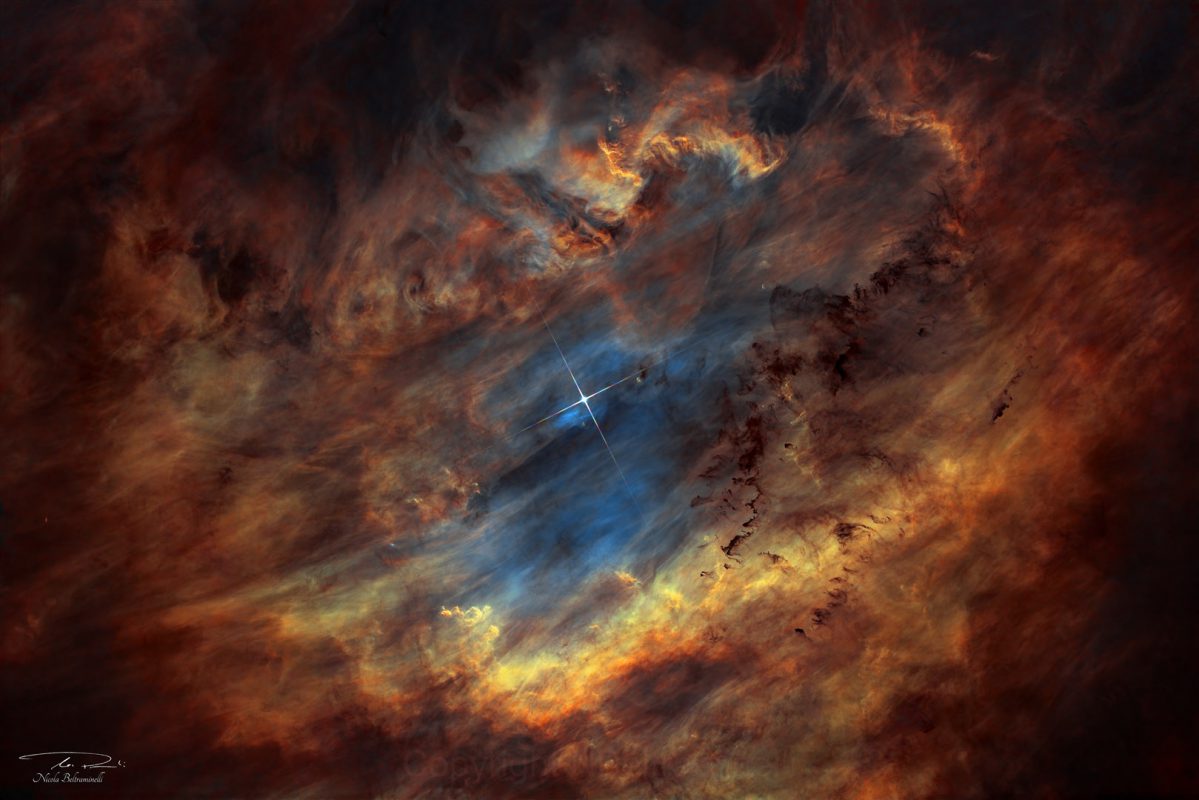
The Lion Nebula (Sh2-0132) — AstroBin Image of the Day 01 October 2022
The Lion nebula has become a very classic imaging target, with no less than 965 pictures uploaded on AstroBin.
As mentioned by many, Sharpless 2-132 is a very faint emission-type nebula on the Cepheus/Lacerta border. Its size is in the order of 40 arcmin, but in reality, if one considers very faint signals, the nebula covers significantly more than a degree. According to what I could find on the Internet, Sh2-132 is located at about 10,400 light-years. The stars responsible for the ionization of its gases are very hot and massive and include two Wolf-Rayet stars: HD 211 564 and HD 211 853 (the latter named also WR 153).
So, with more than 965 images published what can be done to make my image special? Well, by looking at the huge number of beautiful images, I observed that, for many, the level of detail was not very high. Furthermore, despite the huge variations in the color palette, I trusted that by finely tuning the balance, I would be able to find something novel.
So, I focused on achieving a highly detailed Hα layer first. With my 10Micron GM2000 HPS II mount, I was very happy to achieve (manually) pointing models with an accuracy of 1.6 and 1.8 arcsec on the two Hα imaging nights. I think that I never reached such a level of detail on any of my previous images. For the SII and OIII channels, I selected 300 second and 600 second sub-frames respectively, but in reality, I discovered later that the nebula is way stronger in OIII emission than SII. At that point, I started combining the layers and there I saw an option to push for something a bit special. As a matter of fact, in my (limited) experience, this is the first nebula I could capture where all the colors can be observed on the final image without triggering something artificial. In the final image, you can easily detect blue, violet, purple, red, turquoise, green, yellow, orange, etc.
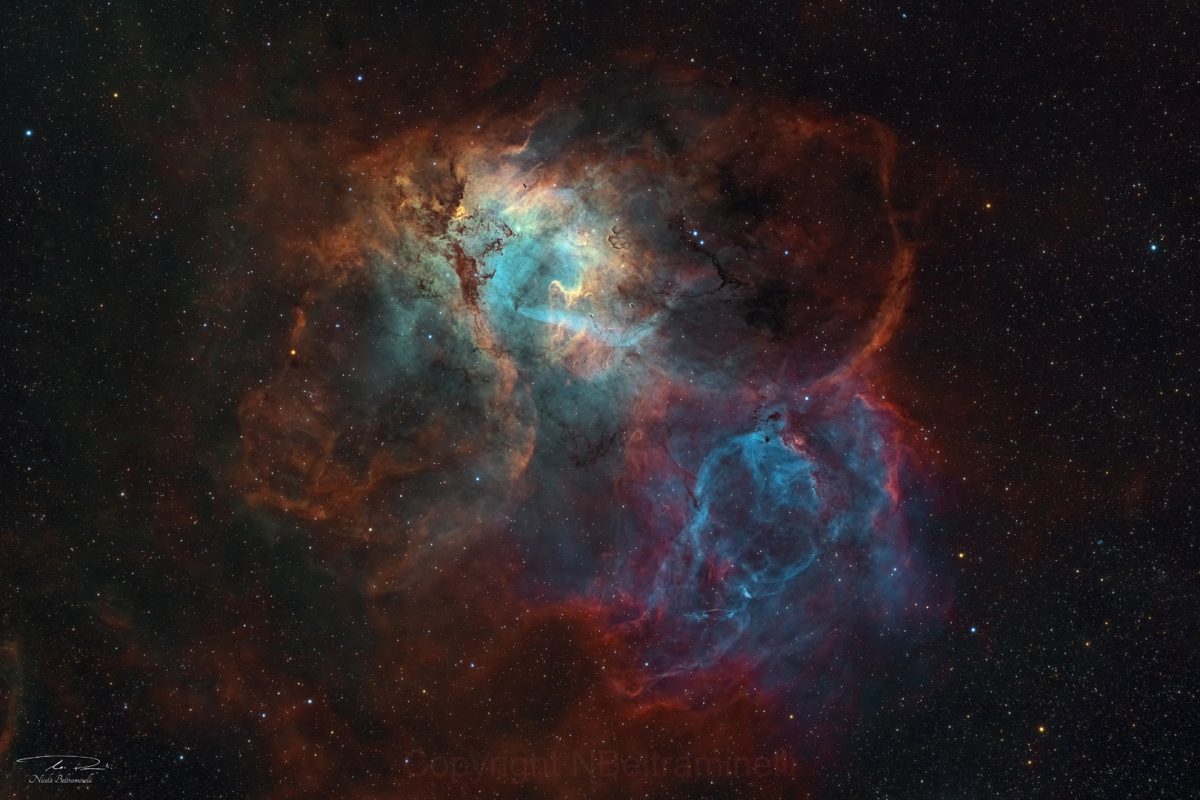
The Horsehead Nebula (Barnard 33)
The Horsehead Nebula is a dark nebula in the constellation Orion. Also known as Barnard 33, the unusual shape was first discovered on a photographic plate in 1888 by Scottish astronomer Williamina Fleming taken at the Harvard College Observatory. The Horsehead Nebula is approximately 1,500 light-years from Earth.
Classically, this wonderful nebula is imaged by using the L filter for the luminance and the RGB channels for the colors. Many imagers also use Hα as an additional contribution to achieve a cleaner, more contrasted signal. The key point is to find the correct balance between Hα and L in Luminance to avoid either too much red or loose details from Hα in the final picture. By playing around with Hα I found that the best solution was to combine 70% opacity in Hα and 50% in L for the luminance, as well as ~35% opacity in Hα and 65% opacity R for the red channel.
I hope that you will enjoy this personal interpretation of the famous Horsehead nebula
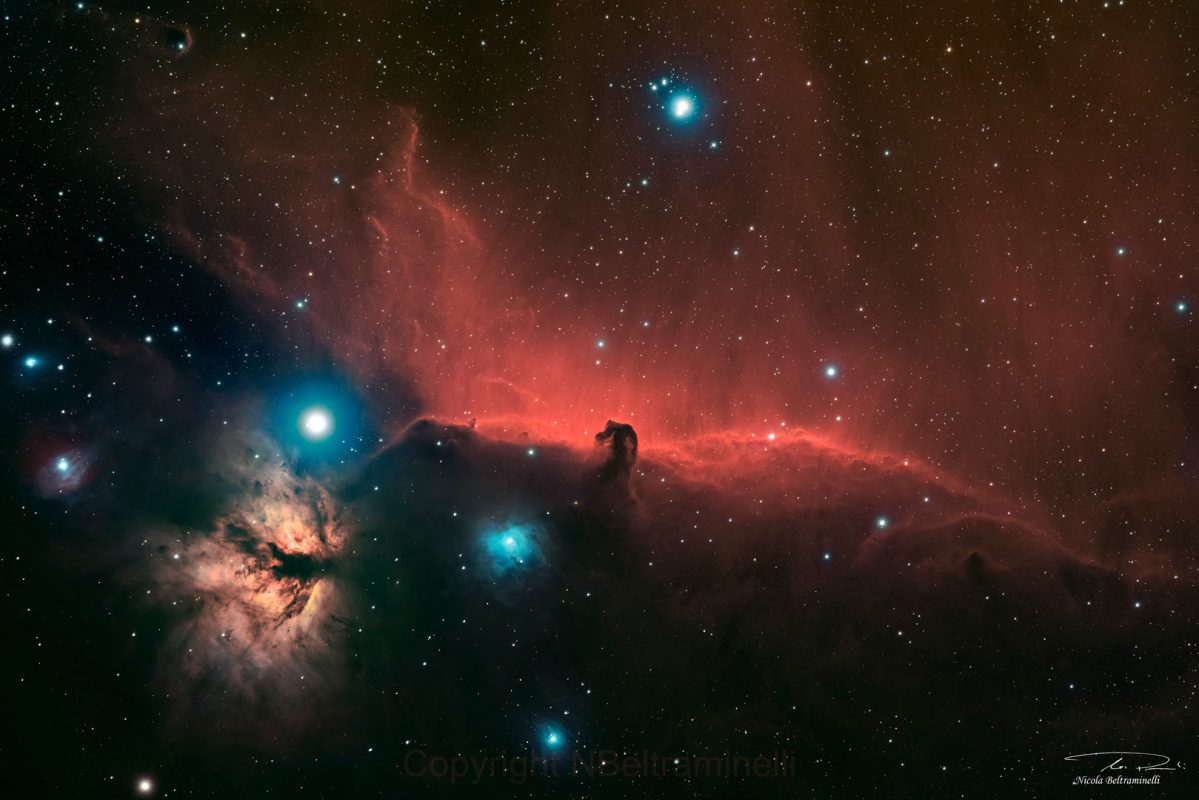
Lagoon Nebula (M8)
The 8th item of the Messier Catalogue is a “must have” target of every astrophotographer. It is extremely bright and easily detectable with small telescopes. The nebula emits very strongly in Hα and OIII, thus in classical RGB photography the color is not red but purple. For astro-beginners, this is the typical low-hanging fruit to start with. But for those located in France, like me, this is not such a piece of cake as one would think. As a matter of fact, the nebula is at the meridian at no more than 19 degrees over the horizon, thus the limitations are by far not only the limited time window to photograph it, but the very high risk to obtain a badly blurred image due to the strong turbulence. To obtain a qualitatively acceptable result of this beautiful and very colorful nebula, I therefore limited the photographic time frame from 1 hr 30 min prior to 1hr 30 min after the meridian. As a matter of fact, my subs outside this window were of very low quality. Furthermore, it was key to select places with very low turbulence and I noticed that having an even small road in front of me was sufficient to generate turbulence due to the higher temperature of the asphalt. By selecting grassy surroundings, the turbulence was significantly decreased. Also, I only selected the calmest nights for imaging. Weather prediction programs such as the MeteoSuisse radar (which covers also part of France) helped a lot in identifying these regions.
About the rationale to shoot in HS-SHO, I noticed that the SII emissions are very particular on this nebula. As a matter of fact, although the SII emissions are significantly fainter than Hα and OIII, they reveal wonderful details invisible in RGB. I decided to use a stronger contribution of SII emissions compared to Hα and OIII and to also use the Luminance channel with a 10% contribution (this is why the image is named HS-HSO).
From the color selection perspective, I pushed the balance to maintain part of the red-pink color of the nebula at the border, while highlighting the powerful OIII emissions and the incredibly detailed structures of SII. Finally, the color selection of each channel is from my perspective more personal taste than anything else.
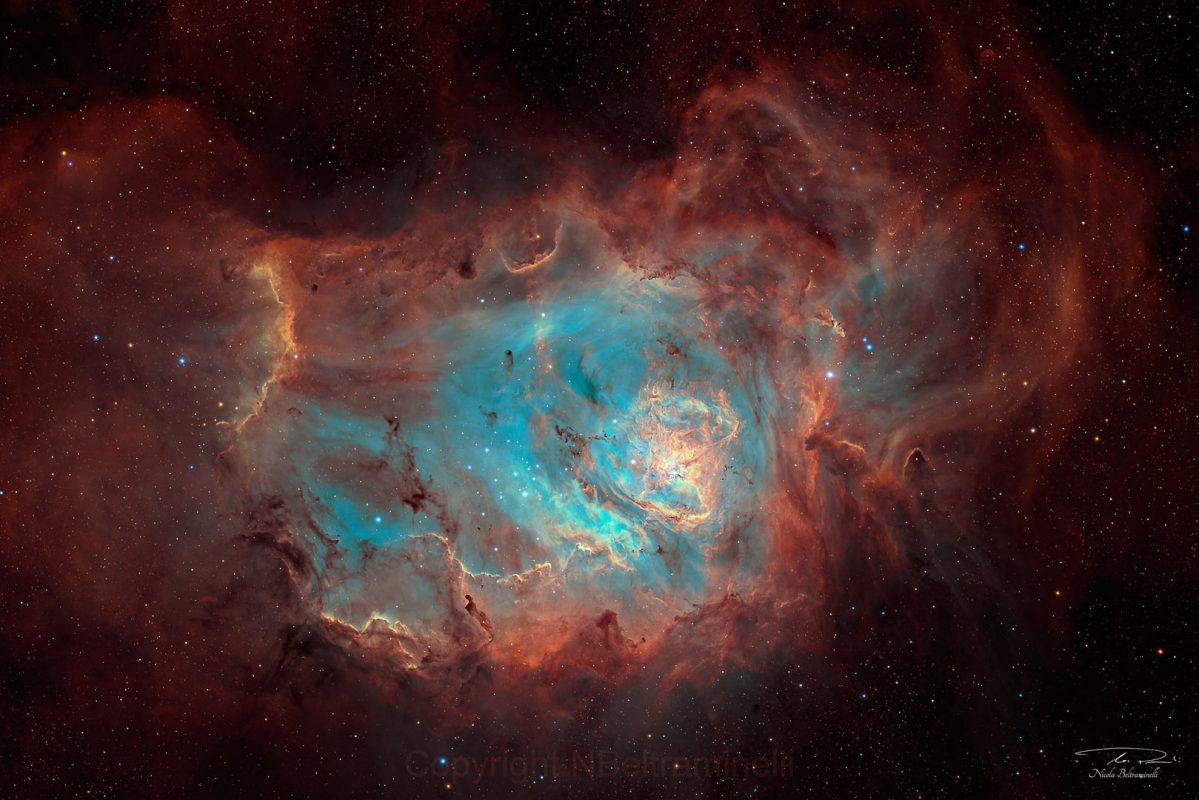
We wish Nicola continued success on AstroBin and look forward to seeing more of his work with the Tele Vue-NP127is.
Did you observe, sketch, or image with Tele Vue gear? We’ll like your social media post on that if you tag it #televue and the gear used. Example:
#TeleVue #NP127is #M8 #LagoonNebula
Do you want your Tele Vue images re-posted on Tele Vue Optics’ Social Media accounts? Use this hashtag for consideration:
More Info
- Visit Nicola Beltraminelli‘s Instagram page.
- More Tele Vue-NP127is image galleries on this blog.
- Learn more about the Tele Vue-NP127is on our website (mobile site).
- Must read: Tele Vue APO Design and Build “Secrets” blog post.
- See our growing list of AstroBin Image of the Day winners (mobile site)




